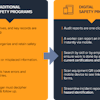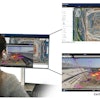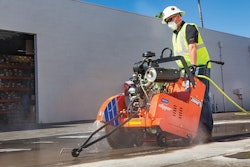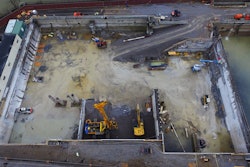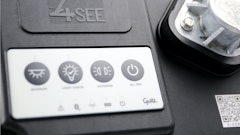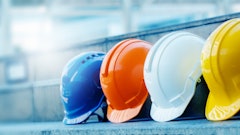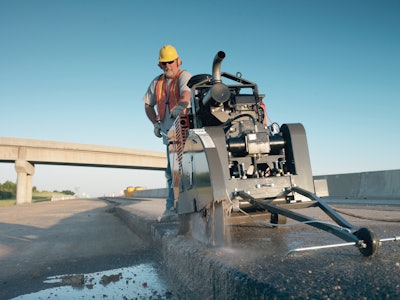
Concrete and asphalt sawing is done to facilitate additions, repairs and modifications to on-going projects such as adding expansion joints, pre-stressed joints, etc. Concrete/asphalt saws are categorized as wet saws and dry saws. Wet saws are generally of a walk-behind type, gas powered and requiring a constant water supply to the blade. Dry saws are generally more portable and set up in a configuration similar to a chain saw. Wet saws are used mainly on flat work for longer cuts, and dry saws are used for vertical or highly sloped smaller cuts.
Following are safety guidelines for concrete/asphalt saws.
Employers must ensure that all personnel who operate concrete saws are properly trained in the safe use of the equipment, including any necessary personal protective equipment. Personal protective equipment (PPE) for sawing operations should include the following:
- Eye protection or a face shield – Flying particles, dust and slurry are eye hazards during concrete and asphalt sawing.
- Gloves – Heavy duty gloves should be worn to protect against lacerations, abrasions and burns from hot equipment parts
- Respiratory protection – Generally a particulate respirator (dust mask) is sufficient for concrete sawing. Change your dust mask often, especially in dry sawing operations. Concrete dust presents the hazard of silicosis.
- Hearing protection – Concrete saws generate excessive noise which can damage hearing. Earmuff style hearing protection may be required. Check with the manufacturer for the exact hearing protection requirements.
- Non-slip footwear – Sturdy, non-slip footwear or steel toe boots should be worn.
- Chaps or leggings – Leg protection should be worn when operating a dry saw.
- Do not wear loose clothing or jewelry which may present an entanglement hazard.
Additional safety items include:
- Inspect saws for missing, loose or broken parts before each use.
- Ensure that all safety guards are in place and secure before operating the saw. Never use a saw without the safety guards.
- Check blades for cracks, warping and excessive wear before running the saw. Do not run a saw with a broken or cracked blade.
- Blades should be ring tested before installation on the saw by inserting a bolt through the center, hold the blade suspended by the bolt and tap the blade with a piece of metal or hammer. The blade should emit a clear ringing tone; a dull short tone may indicate a cracked blade, and the blade should be thoroughly inspected or replaced.
- Ensure that the blade is properly tightened before using the saw.
- Use only enough water with wet saws to cool the blade and lubricate the cut, excessive water will flood the job and make seeing the cut difficult and footing hazardous.
- Never try to turn the blade in a cut, raise the blade out of the cut and begin a new cut at the necessary angle. Turning during a cut will bind the blade and may shatter the blade or damage the saw.
- When using dry saws, ensure that you have a firm grip before beginning your cut, and at all times during the cut.
- Start a dry cut saw on the ground with your foot on the hold down plate or handle.
- Shut off the saw when the cut is complete and when moving from one cutting area to another.
- Do not force a concrete saw; let the blade cut at its own speed. Forcing the saw or excessive pressure may break or jam the blade, damage the saw, and causes premature and expensive wear to the blade.
- Do not begin cuts through bond beams or support structures when making vertical cuts until the load is relieved by sufficient blocking or bracing.
- Do not fuel concrete saws while the engine is running or hot. Let the engine cool first and clean up any spilled fuel.
- Do not allow bystanders in the vicinity of cutting operations.
- Ensure that all personnel in the vicinity of sawing operations wear the proper personal protective equipment.
- Use proper temporary traffic control measures for any sawing operations in the vicinity of vehicle traffic.
